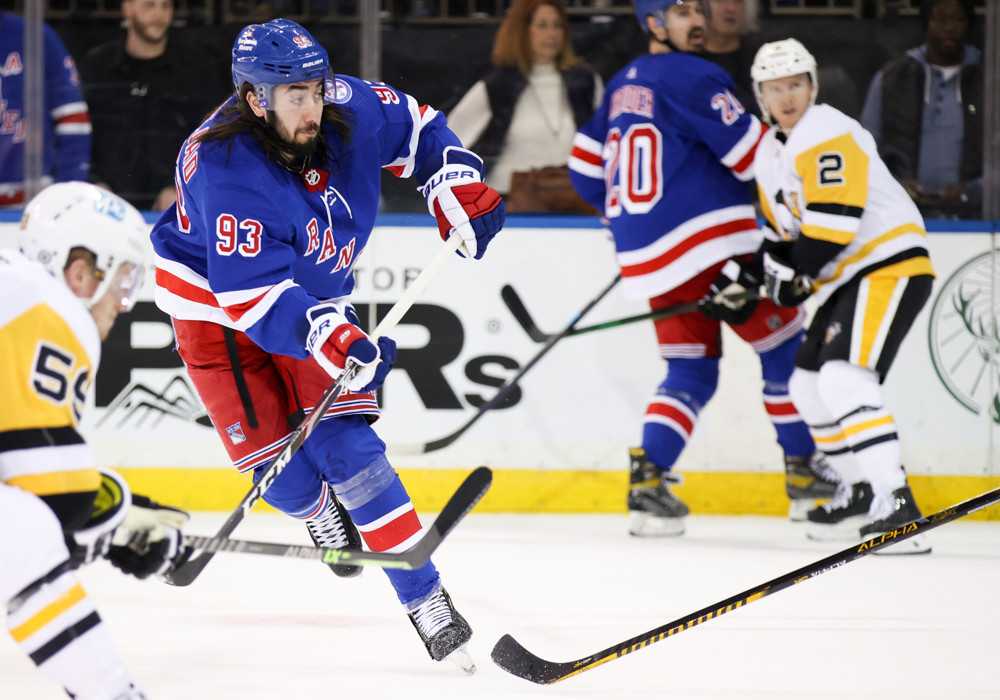How Mika Zibanejad Struck the Optimal Balance
When the Ottawa Senators shipped 23-year-old Mika Zibajenad to the New York Rangers for Derick Brassard in July 2016, they were trading high potential for a finished product. The Sens were looking to contend and felt as though they couldn’t afford to wait for their former sixth overall pick to realize his potential.
As it turns out, Zibanejad (68 points in 66 games) is still growing six seasons later—and the Rangers wouldn’t have it any other way.
Following a 41-goal campaign in 2019-20 during which he emerged as one of the Eastern Conference’s deadliest snipers, he’s quietly but effectively tipped the scale toward the playmaking side. Through 66 games this year, he ranks 29th leaguewide in assists and 18th in primary helpers. This passing bent has been especially fruitful for linemate Chris Kreider, whose 44 goals put him firmly in the Rocket Richard conversation as we head down the home stretch. For a bit of context, Kreider put up exactly that same tally over the two previous seasons. In 113 contests. Yeah…he’s not too upset about Zibanejad’s evolution.
Now, it’s worth mentioning that the 28-year-old Swede has always been a capable passer. Watch him for a few games, and you’ll notice his soft touch and first-class vision. He can serve up immaculate saucer passes, laser pucks to the backdoor or shift the point of attack in order to create the best possible passing lane. His powerful skating is also helpful in backing off defenders and buying himself more room to operate in. In a nutshell, he has all the makings of an excellent playmaker:
Zibanejad has repeatedly hit Kreider in stride this season so that the speedy winger can break in alone and flex his finish. Due to their wheels, Zibanejad’s passing ability and Kreider’s efficiency (21.3 SH%), this duo is terrifying on the counterattack. If you turn the puck over, they’ll bury it in your net in a matter of seconds.
In non-rush scenarios, Zibanejad has developed a taste for backdoor playmaking. He often connects with Kreider by the far post for a gimme tap-in, first looking away to sell another threat and then whistling the puck directly on to his teammate’s blade. The rest is a formality. There’s a reason Kreider ranks second in high-danger expected goals. He’s consistently been put in favorable situations, and as a credit to him, he’s cashed in.
On the power play, Zibanejad thrives within New York’s umbrella. He works with Adam Fox and Artemi Panarin to move the puck quickly and keep the penalty-killers guessing. He’s particularly adept at exploiting the circle-to-circle seam, opening up a world of possibilities with each royal-road pass. However, defenders won’t get away with leaving Kreider unattended either. This makes for a potent man advantage (2nd in the league).
There’s no doubt that he’s shown a greater willingness to pass the puck in recent seasons. However, the key to both Kreider’s goal-scoring explosion and his own playmaking spike has been when he’s deciding to dish:
Take note of how frequently he passes out of quality shooting opportunities in order to generate an even better chance. How do you even handle this? He’s scored at a 38-goal pace over the past four years, but his shooting rate in all situations has actually dipped for the third consecutive season. His skill set suggests he can wire the puck past goaltenders, but if you commit to the shot, he’ll make the extra pass to a teammate faced with a yawning cage.
On the flip side, Zibanejad isn’t Teuvo Teravainen or Mathew Barzal. You can’t cheat toward the passing option because he remains a legitimate trigger man who will make you pay in a hurry. His specialty is the stick-side one-timer, and though he doesn’t really mix up his targets, his accuracy is clinical enough to consistently beat goaltenders to the top corner:
Goaltenders are trapped between a rock and a hard place.
To further twist the blade, Zibanejad can convert in a variety of ways beyond his lethal one-timer. He boasts a heavy wrister on the rush that can fool netminders from distance, he has the quick hands required to capitalize on loose pucks in tight and he has the skill to shake goaltenders in one-on-one situations.
He’s still a very real threat to score. After all, he has 26 markers this season. He can blast pucks through you or use his speed and 6’2”, 200-pound frame to bang down your front door:
Kreider isn’t a natural playmaker. Alexis Lafreniere hasn’t turned the corner as a pro yet. Newcomer Frank Vatrano is a meat-and-potatoes, shoot-first forward. If Zibanejad doesn’t position himself as a dual threat rather than a pure shooter, New York’s top line can’t reach its ceiling. It looks as though it has in 2021-22, as the Rangers are at their most productive when Zibanejad is on the ice (4.89 GF60). That number is a career high as well.
Where he was once on the verge of falling in love with his shot, he’s shed that tunnel vision to become a well-rounded offensive force who will set up teammates or unleash rockets depending on the best option available. Sure, he may not control a huge share of the action (49.4 xGF% at 5-on-5), but he’s learned how to make the most out of each hand he’s dealt.
He’s never been more dangerous with the puck on his stick.
Recent Posts

How Corey Perry Is Making His Presence Felt With the Lightning
View Post »
How Adam Fox Pushed the Rangers Past the Penguins
View Post »

